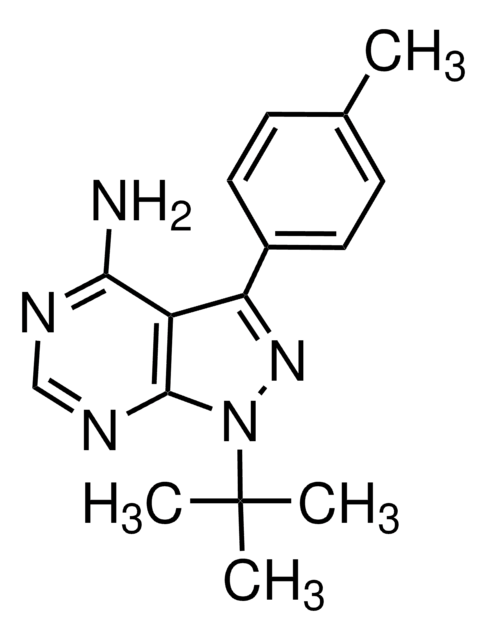529573
PP2
≥95% (HPLC), solid, Src protein tyrosine kinase inhibitor, Calbiochem®
Sinonimo/i:
PP2, AG 1879, 4-Amino-5-(4-chlorophenyl)-7-( t-butyl)pyrazolo[3,4-d]pyrimidine
About This Item
Prodotti consigliati
product name
PP2, PP2, CAS 172889-27-9, is a potent, reversible, ATP-competitive, inhibitor of the Src family of protein tyrosine kinases (IC₅₀ = 4, 5, 5, &100 nM for p56lck, p59fynT, Hck, & Src, respectively).
Livello qualitativo
Saggio
≥95% (HPLC)
Forma fisica
solid
Produttore/marchio commerciale
Calbiochem®
Condizioni di stoccaggio
OK to freeze
Colore
off-white
Solubilità
DMSO: 20 mg/mL
Condizioni di spedizione
ambient
Temperatura di conservazione
−20°C
InChI
1S/C15H16ClN5/c1-15(2,3)21-14-11(13(17)18-8-19-14)12(20-21)9-4-6-10(16)7-5-9/h4-8H,1-3H3,(H2,17,18,19)
PBBRWFOVCUAONR-UHFFFAOYSA-N
Descrizione generale
Azioni biochim/fisiol
p56lck
Confezionamento
Attenzione
Nota sulla preparazione
Altre note
Salazar, E.P., and Rozengurt, E. 1999. J. Biol. Chem. 274, 28371.
Hanke, J.H., et al. 1996. J. Biol. Chem.271, 695.
Selected Citations
Lee, J., et al. 2009. Cell Stem Cell5, 76.
Note legali
Codice della classe di stoccaggio
11 - Combustible Solids
Classe di pericolosità dell'acqua (WGK)
WGK 3
Certificati d'analisi (COA)
Cerca il Certificati d'analisi (COA) digitando il numero di lotto/batch corrispondente. I numeri di lotto o di batch sono stampati sull'etichetta dei prodotti dopo la parola ‘Lotto’ o ‘Batch’.
Possiedi già questo prodotto?
I documenti relativi ai prodotti acquistati recentemente sono disponibili nell’Archivio dei documenti.
I clienti hanno visto anche
Il team dei nostri ricercatori vanta grande esperienza in tutte le aree della ricerca quali Life Science, scienza dei materiali, sintesi chimica, cromatografia, discipline analitiche, ecc..
Contatta l'Assistenza Tecnica.









